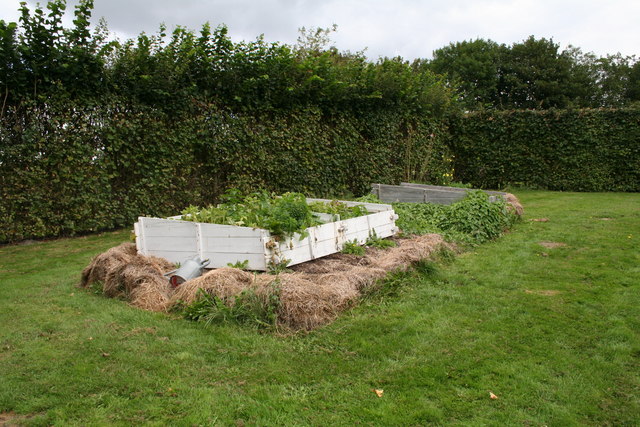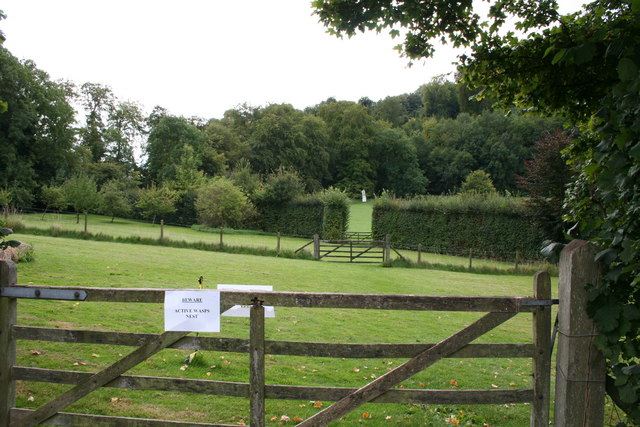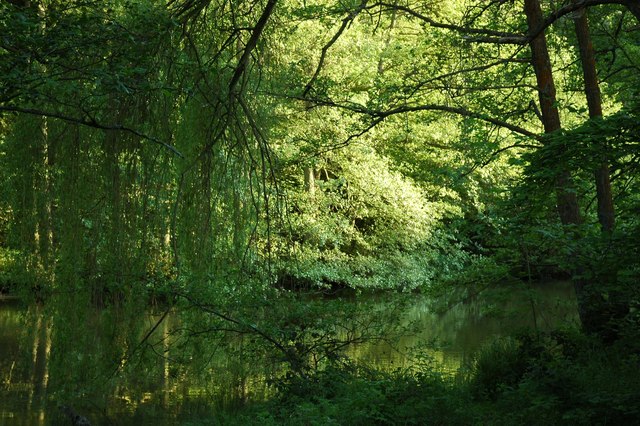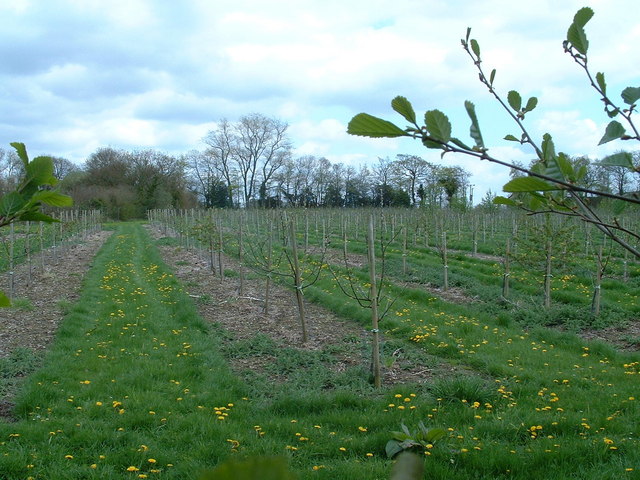.
A view from the back garden of Gilbert White's house, The Wakes, Selborne, Hampshire: photo by Ludi Ling, 26 August 2010
25 July, 1790
Lime trees are fragrant: the golden tassels are beautiful. Dr
Chandler tells us that in the south of France, an infusion of the
blossoms of the lime-tree, tilia, is in much esteem as a remedy for
coughs, hoarseness, fevers, etc.; and that at Nismes he saw an
avenue of limes that was quite ravaged and torn to pieces by people
greedily gathering the bloom, which they dryed and kept for their
purposes. Upon the strength of this information we made some tea of
lime-blossoms, and found it a very soft, well-flavoured, pleasant,
saccharine julep, in taste much resembling the juice of liquorice.
25 July, 1789
25 July, 1786
25 July, 1785
25 July, 1783
Some young martins came out of the nest over the garden-door.
This nest was built in 1777, and has been used ever since. As the
summer has been dry, and we have drawn much water for the garden, I
caused my well to be plumbed, and found we have yet 13 feet of water.
When we were measuring I was desirious of trying the depth of Bentham’s
well, which becomes dry every summer; and was surprized to find it 25
feet shallower than my own: the former being only 38 feet deep, and
the latter 63.
25 July, 1781
25 July, 1779
Puff-balls come up in my grass-plot, and walks: they came from the common in the turf. There are many fairy-rings in my walks, in these the puff-balls thrive best. The fairy-rings alter and vary in their shape.
Puff-balls come up in my grass-plot, and walks: they came from the common in the turf. There are many fairy-rings in my walks, in these the puff-balls thrive best. The fairy-rings alter and vary in their shape.
25 July, 1778
The water shines in the fallows. Much damage done about London by lightening on July 20.
25 July, 1776
Bees that have not swarmed kill their drones.
25 July, 1774
Grapes very small and backward for want of sun. qu: if they will ripen.
*They did in Octr.
*They did in Octr.
25 July, 1773
Some hops much infested with aphides.
25 July, 1772
Wheat turns yellowish. Mercury falls very fast.
25 July, 1768
Cut the first cantelupe-melon.
Gilbert White (1720-1793): from Naturalist's Journal (entries for 25 July, 1768-1790) in Journals, edited by Walter Johnson, 1931

Hot Beds used by Gilbert White. Gilbert White successfully grew melons in these hotbeds. A pit is dug and filled with fresh horse manure, on top of which is a foot or so of good loamy soil. The manure ferments and produces a high temperature which aids the germination of the seeds. If required, glass can also be placed across the frame: photo by Dr Neil Clifton, 2 September 2007

Gilbert White's garden, Selborne, Hampshire. Gilbert White was not a rich man and could not afford statues to decorate his garden. Instead he used wooden boards painted to resemble statues at the end of sight lines as here through the field gates: photo by Dr Neil Clifton, 2 September 2007

The water below Outshott hangar. Stagnant in places. We saw a owl fly off in between the trees as we walked back: photo by Andrya Prescott: 3 June 2006

Noar Hill from the Hangers' Way path on the south side of Selborne Hill: photo by Keith Rose, 8 June 2004

Looking south from Noar Hill. The ploughed field forms the plateau-like summit of Noar Hill. Almost surrounding the field is a glorious wildlife reserve: photo by Hugh Chevallier, 8 October 2006

Hawkley Hanger, from footpath at Vann Farm, Empshott. On Hangers Way: photo by Keith Rose, 6 May 2006

Hangers near Empshott. Another section of the boundary between the hangers and open farmland: photo by Graham Horn, 4 March 2007

Footpath towards Empshott. Take your pick of which bit of mud you wish to use: photo by Graham Horn, 4 March 2007

Byway through the Woods. Taken on the byway to Selborne Priory through the woods east of Selborne: photo by Ron Strutt, 23 March 2003
for Karen and Duncan Jones











Of Gilbert White's uniquely observant, precise, artful and curious Journals his biographer Richard Mabey has commented: "...it is possible to read the journals as a simple historical record of natural events, and spanning forty years without a break... yet it is the lucidity and resonance of the best of the entries that are his most important legacy. Stripping away pastoral allusions, adjectival excess, self-examination, searches for meaning, he distilled a form of spare, literary miniature which had an immediacy not seen in this kind of prose before... Yet it is doubtful if White saw his journals as 'writing' in any literary sense. For him, I think, they were his intellectual ledger, where he took stock of his understanding of the physical world. They always have this probing, investigative sense about them that lifts them beyond merely passive records..."
ReplyDeleteAnd see also:
ReplyDeleteAbundance
Hampshire, July 25th 2012
ReplyDeleteThe sun finally arrives after weeks of cold and rain. Re-planting carrots. The courgettes, like the pastoral allusions, stripped away by the slugs.
Jonathan,
ReplyDeleteNothing more useful than the local knowledge.
But ah, the sodden slug infested pastoral! Alas, the lovely convoluted fuzzy yellow flower lost!
Tom,
ReplyDeleteLovely indeed, to think that it was all going on there, back then. Here's Dorothy Wordsworth's journal entry for July 25th --
"But the day after Friday July [25th] still hotter. All the morning I was engaged in unpacking our Somersetshire goods & in making pies. The house was a hot oven but yet we could bake the pies -- I was so weary I could not walk so I went & sate with Wm in the orchard -- we had a delightful half hour in the warm still evening."
7.25
light coming into fog against invisible
top of ridge, bird chirping from branch
in foreground, sound of wave in channel
sketch of, views that stood
at odds with the fact
sense of something, what is
by way of, appears in
grey white of sky to the left of point,
shadowed green pine on tip of sandspit
A good,soft English light in all the photos.
ReplyDeleteI love the line: "Wheat turns yellowish. Mercury falls very fast".
Wheat and mercury together; something almost alchemical there.
A wonderful post, TC
"The only place where omens possess any reality is inside that sad prison, the human mind."...TC
ReplyDeletebeautiful pics!!
The “lovely convoluted fuzzy yellow flower” makes for one of summer’s yummier delicacies over here in Hellas but first someone has to get up very early and pick them before the heat wilts them; after that, just leave it to the wife to stuff and cook them. Gusto perfecto!
ReplyDeleteI love this and all the comments also, esp. your initial one and WB's note. I will be eternally grateful for your introduction to Gilbert White. I keep White by my bedside and he never fails to restore me when I think nothing possibly can. Curtis
ReplyDeleteSo rich, so beautiful. I want to live there, teeth sinking into everything, into escape. I see a softness that is welcome to contrast the harsh. Healing, gorgeous. That's why people go there--more than lavender to attract the bees.
ReplyDeleteWheat and mercury surely represent a poetico-alchemical conjunction.
ReplyDeleteTo sit with Dorothy and William in the orchard in the warm Somerset evening, after the baking of the pies, a heavenly imagination.
The buzzing of the bees about the wild lavender in the zucchini patch...
I love the mental picture I have of Gilbert and John White clearing and constructing the Zigzag path. A poetry of place that first pitches in with the literal fashioning of the place, long before beginning the loving annotation of its natural history.
He improved the land and improved the knowledge we have of the things that lived upon it. "He added the harvest mouse and the noctule bat to the list of British mammals, and was the first to distinguish clearly the three species of 'willow wrens'," as his great editor Walter Johnson tells us.
All evidence indicates he was a cheerful, witty, mild and endlessly curious man. There is scant report of his ever having been cross with anyone about anything. The one instance noted is the story concerning his manservant, Thomas Hoar. Hoar was a few years older than White; in the end he survived White by four years, reaching the grand age of eighty-three. White left him a generous legacy in his will. There were those who felt Hoar took liberties due to his privileged position in the household; that he had been "spoilt" by White's exceptional kindness and generosity. But only one tale survives of White coming even near to losing his temper with Hoar. Hoar is to have broken a glass, and confessed it. How did you do that, then, Thomas? enquired GW. "I'll show you, Sir," declared Hoar, who promptly went and got another wine glass, and dashed it upon the floor. "There, go along Thomas! you are a great fool," White said; and then muttered, "And I was as great a one for asking such a foolish question."
The secret hero of his Journals is Timothy the Tortoise, bequeathed to him by an aunt, Mrs Snooke of Ringmer. Timothy was a great favourite of White's, but White being White, this meant Timothy often found himself involuntarily participating in the naturalist's scientific experiments. Immersion in water, for example, brought little joy to Timothy. Small wonder then we often find him burrowing-in for the long haul.
This would begin in late autumn.
White began to note these seasonal retirements when Timothy was still at Ringmer.
"1 November, 1771. Mrs Snooke's tortoise begins to dig in order to hide himself for the winter...
"10 November, 1771. Tortoise comes out in the sun about noon, but soon returns to his work of digging a hole to retire into..."
The pleasure of observing animals and plants in their ways of living and being was for White a form of love.
One could write a book about his relations with Timothy, for example.
(In fact, someone has done!)